Astronomy and Astrophysics
MajorMinor3YRBachelor of Science

Program Information
Curriculum
Sample courses in this program include:
- AS 102 – Modern Astronomy
- AS 301 – Modern Astronomical Techniques
- AS 311 – Astrophysics
- AS 340 – Cosmology and Extragalactic Astrophysics
- PH 201 – Introduction to Analytical Physics
Three-Year Program
The Astronomy and Astrophysics major can be completed in a total of three years, which includes completing coursework during both summer terms. More information can be found here.
Meet Your Faculty
View All Faculty
Natalia Andreev
Lecturer – Physics
Physics and Astronomy – LAS
Physics and Astronomy – LAS
My area of research is observational radio astronomy: – observation of regions of massive star formation in our galaxy using: Green Bank Telescope (GBT), Very Large Array (VLA), and the Atacama Large Millimeter/submillimeter Array (ALMA).- study of…
View more about Natalia Andreev
View more about Natalia Andreev

Xianming Han
Professor – Physics
Physics and Astronomy – LAS
Physics and Astronomy – LAS
Ph.D., 1989, University of Colorado, Boulder.Visiting Assistant Professor of Physics, 1989-1991, University of Idaho, Moscow.Assistant Professor, Associate Professor, Professor, 1991-present, Butler University, Indianapolis.Recent teaching duties:NW…
View more about Xianming Han
View more about Xianming Han

Aarran Shaw
Assistant Professor – Physics
Physics and Astronomy – LAS
Physics and Astronomy – LAS
My research focuses on accreting compact objects. When stars die they leave behind very dense remnants, which, depending on mass of the progenitor star, can be a white dwarf, neutron star or black hole. Many of these objects can be found in binary…
View more about Aarran Shaw
View more about Aarran Shaw
REQUEST INFORMATION
Whatever path you’re interested in pursuing, there’s a place for you at Butler.
Loading…

